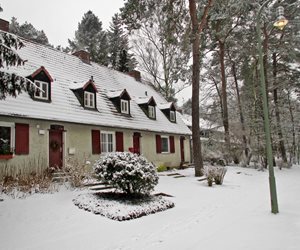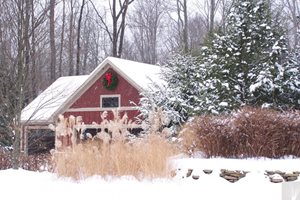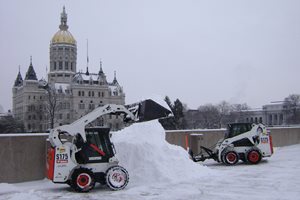Snow Removal
Compare snow plowing with snow removal & find out which service is best for your propertyIn winter, many landscaping companies keep their clients' driveways, pathways, roofs and landscapes usable by offering a snow removal or snow plowing service. During snowy weather, the crew will work from midnight through the morning to clear snow and allow everybody to get to work and school on time. Here, we've spoken with landscapers who offer snow management services to learn about the most common options.
Snow removal vs. snow plowing
Although the terms snow removal and snow plowing are sometimes used interchangeably, "snow removal refers to actually removing the snow from the site, while snow plowing means you are pushing it into a pile and leaving it on the property," says Kyle Ritchie of Milieu Design LLC in Wheeling, IL.
Snow removal is:
- More common in commercial settings - Most businesses have large parking lots full of snow and not much space to store it.
- Good for urban lots - On smaller properties, there may not be any place to store a pile of snow until spring.
- More expensive - Because the snow needs to be scooped up and trucked to another location, snow removal is a pricier option than simply plowing.
Snow plowing is:
- More common in residential settings - Many homes have room off the side of the driveway or on the lawn to leave a pile of snow until spring.
- More economical - On most properties, snow plowing is an efficient service which costs a lot less to perform than snow removal.
Types of snow management services
"Most snow management is about creating safe egress and space around doors, front walkways, and driveways," says Ritchie. Following are the most common services offered.
Clearing driveways.
Your snow management company may use a plow to clear the driveway, or a snow blower attached to a skid steer. Wider driveways are faster and less costly to clear, while narrow driveways with a lot of obstacles drive up the cost considerably.
Clearing front walkways.
The crew can use a shovel or mechanical broom to clear the front walkway. Most people don't bother clearing all of the paths through the landscape, just the front walk.
Using deicing products.
While the best products vary by region and temperature, most companies will use some combination of sand and salt on driveways and walkways to keep them from icing up. Gerry DuBreuil of Belknap Landscape Co., Inc in Gilford, NH recommends acetate deicing products because they are less corrosive and don't harm plants.
Shoveling snow from roofs.
If your architecture is such that snow could fall off the roof and block your front door or crush landscaping plants, you may want to consider shoveling the snow off your roof. Again, whenever you are managing snowfall, you have the option of either removing the snow from your property, or pushing it into a pile off to the side where it can melt in spring.
Cost of snow management
A number of factors go into the price of snow removal and plowing. "A few factors we look at are whether there is good access to the property, how much area there is, and whether there are any obstacles in the way," says DuBreuil. "We may be able to reduce the price if we have a number of clients in the area."
How snow management is billed:
- By the season - Your landscaper can formulate a quote based on the average snowfall over the last few years. The advantage here is that you know how much you will pay at the beginning of the season, even if there are unexpectedly large storms. The disadvantage is that even if you have a light snow season, you still pay the same amount.
- By the inch - In this scenario, your landscaper would give you a sheet with rates for differing amounts of snowfall. You'd pay one price for 1 to 3 inches of snow, a higher rate for 3 to 6 inches of snow, and a more for 6 to 9 inches of snow. This is a fair way of billing because you pay for exactly the service you receive.
- By the hour - Special tasks such as roof shoveling or clearing pathways may be billed by the hour. Light, powdery snow is a lot faster to shovel than is wet and slushy snow.
Because there are so many factors that go into snow management, you'll need to get a quote that takes into account the specifics of your property. For example, an average residential property may cost $50-$75 to plow, but a property with the same area that has a narrow drive, an electric gate to maneuver around, and landscaping right up to the driveway may cost $125-$145.
Snow removal services cost about twice as much as simply plowing. So where possible, try to plan for snow storage during the design phase of your project, because a little forethought in this regard can save you quite a bit of money over the years you will own your property.

 Backyards
Backyards
 Front Yards
Front Yards






